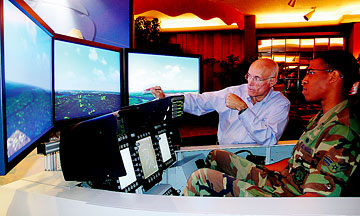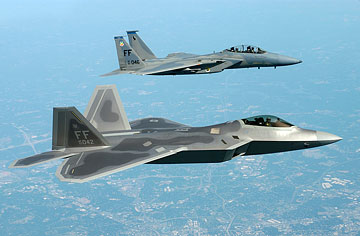 ASSOCIATED PRESS Keith Bilyeu, left, works with Airman 1st Class Matthew Owens last week on a F-22A Raptor simulator at Elmendorf Air Force Base in Anchorage, Alaska. CLICK FOR LARGE |
|
Need for Raptors doubted
Some critics say the F-22 jet is overpriced and unnecessary
By James Halpin / Associated Press
ANCHORAGE, Alaska » The U.S. Air Force's most technologically advanced -- and expensive -- fighter jet, the F-22 Raptor, is designed to be a stealthy killer capable of downing bogies at supersonic speeds.
But critics say the changing nature of warfare in the age of terrorism, combined with the unparalleled superiority of U.S. air power, make the Cold War-era-conceived Raptor an overpriced luxury.
"The real issue is, Who are we going to fly the F-22 against?" asked military aviation author and lecturer James Stevenson. "I don't think al-Qaida is going to shrink back into their caves because there are F-22s flying overhead rather than F-16s."
Elmendorf Air Force Base in Alaska is getting the first of 40 Raptors this week, making it the first base outside of the contiguous U.S. to house them. When their arrival is complete at the end of 2008, the base will be home to more than a fifth of the Air Force's Raptors.
The Hawaii Air National Guard is due to get its own squadron of F-22s in about four years.
The fighter is capable of cruising faster than Mach 1.5 -- 1 1/2 times the speed of sound, or about 1,150 mph -- without using its afterburner. It can perform tactical maneuvers at altitudes greater than 50,000 feet, far superior to current fighters. Its stealth capability means it can attack air and ground targets before they even know it is there.
But that comes at a steep cost.
The basic sticker price is $135 million per plane. When research, development and testing costs are factored in, the cost balloons to more than $350 million each.
Initial plans called for buying 750 Raptors, but increasing costs have cut that drastically. The Air Force now says it needs 381 of the planes, but it might not have funding for more than 183. The planes are being built by Lockheed Martin, Boeing and Pratt & Whitney.
The program has gotten bogged down by competing interests that want their products in the aircraft, said Pierre Sprey, a former systems analyst for the Defense Department and a designer of the F-16 and the A-10 Thunderbolt. Combined with the Air Force wanting the Raptor to be a technological marvel packed with everything that would fit, that has resulted in poor planning and the program's exorbitant cost, he said.
"They made it so complicated and hopeless that it took forever," Sprey said. "It's just disgraceful."
Pursuing the stealth technology was simply a waste of time and money, he said, because it is not possible to completely cloak a fighter against long-wave or infrared radar.
Retired Air Force Col. Everest "Rich" Riccioni of the Pentagon's advanced tactical fighter program was one of the early planners for the Raptor prototype. Since its conception in 1981, it has morphed from a streamlined, surgical fighter into an overpriced and bloated technology showcase, he said.
"When you design something with a lot of capability, it's got to have a purpose," Riccioni said. "We don't have an air superiority problem. The purpose isn't there."
When planning for the Raptor first began, it was intended to combat aerial Soviet Union threats. It has since evolved into a versatile fighter capable of striking ground targets and conducting information warfare.
But that evolution has cost the project, both politically and mechanically.
 ASSOCIATED PRESS / MAY 2005 In this photo released by the U.S. Air Force, an F-22A Raptor, front, flies next to an F-15 near Langley Air Force Base, Va. CLICK FOR LARGE |
|
Earlier this year, six Raptors were participating in an inaugural flight between Hawaii and Kadena Air Base on Okinawa, Japan, when several of them experienced computer glitches that crippled their navigation systems and hindered communications.
As a result, the Air Force had to repair 87 of the fighters that faced similar problems.
And in March 2004 the General Accounting Office, the nonpartisan investigative arm of Congress now known as the Government Accountability Office, said in a report the plane has had problems with its tail fins, canopy and computer software. It also said the Raptor's avionics processors, developed in the 1980s, are obsolete, and replacing them will take years and cost hundreds of millions of dollars.
While the Air Force tries to work out the kinks in the fighter, a congressional spending cap coupled with the jet's rising costs has kept whittling away at the number of jets it can afford.
But Air Force officials say cost notwithstanding, the Raptor is long overdue because the commonly used F-15 is an aging relic.
Lt. Col. Mike Shower, squadron commander for the first Elmendorf Raptors, said no enemy aircraft even comes close to the F-16. But that does not mean the Air Force should maintain the status quo, he said.
"Our old stuff is essentially on par," said Shower, who has piloted both the Raptor and the F-15. "There is a significant amount of threat out there, but the F-22 absolutely dominates when we fly."
Raptors will replace a squadron of F-15s at Hickam Air Force Base in Hawaii beginning in 2011, and they will also replace F-117s that are based at Holloman Air Force Base in New Mexico.
Those upgrades are much needed, said Loren Thompson, of the Virginia-based Lexington Institute think tank.
He said the Air Force's F-15s are "falling apart" and that although the F-16 is still far superior to other fighters, maintaining a decisive technological edge is essential to deterring military threats the U.S. might face.
"People are so preoccupied with terrorists that they aren't thinking about fighter aircraft," he said. "But if we didn't buy the F-22, we would have a reason to worry."
Hawaii to get 20 F-22s by 2011
Twenty F-22 Raptors, fifth-generation Air Force fighters, will be stationed at Hickam Air Force Base and owned by the Hawaii Air National Guard's 199th Fighter Squadron by 2011.
They will be crewed by pilots from the active Air Force's 531st Fighter Squadron. More than 600 Hawaii Air Guard and Air Force personnel will be assigned to the two squadrons.
The Raptors will replace the aging F-15 Eagles that the 199th Squadron has flown since 1987.
Maj. Gen. Pete Pawling, commander of the Hawaii Air Guard's 154th Wing, said the partnership is the reverse of an arrangement for the C-17 Globemaster cargo jets. Under that arrangement the Air Force owns the C-17s, but pilots and flight crews from the Hawaii Air Guard work out of the same shop and fly the massive cargo jets.
Star-Bulletin staff
|

